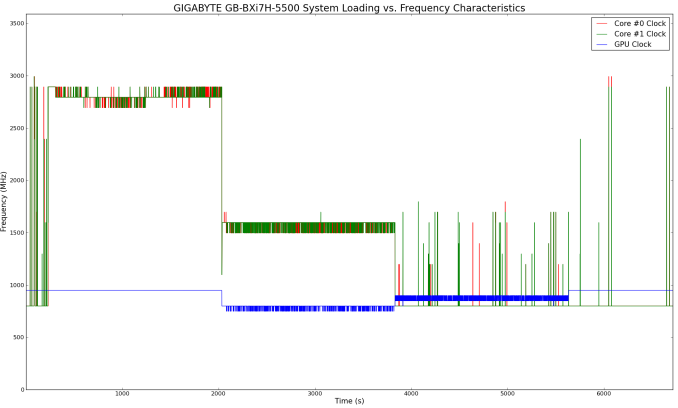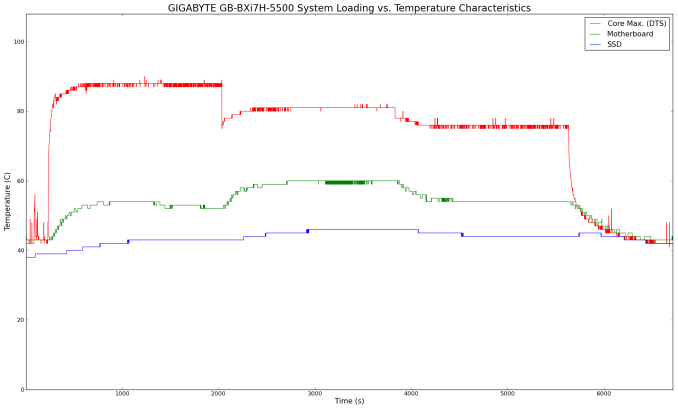GIGABYTE GB-BXi7H-5500 Broadwell BRIX Review
by Ganesh T S on January 29, 2015 7:00 AM ESTPower Consumption and Thermal Performance
The power consumption at the wall was measured with a 1080p display being driven through the HDMI port. In the graphs below, we compare the idle and load power of the GIGABYTE GB-BXi7H-5500 with other low power PCs evaluated before. For load power consumption, we ran Furmark 1.15.0 and Prime95 v28.5 together. The numbers are not beyond the realm of reason for the combination of hardware components in the machine.


The slightly higher base clocks in the Core i7-5500U (compared to the Core i7-4500U) are probably the reason for the Haswell-based unit appearing more power efficient than the Broadwell counterpart - but, make no mistake here - the Broadwell unit wins the performance per watt test quite easily.
The evaluation of the thermal performance was performed by monitoring the various clocks in the system as well as the temperatures with the unit when subject to the following workload. We start with the system at idle, followed by 30 minutes of pure CPU loading. This is followed by another 30 minutes of both CPU and GPU being loaded simultaneously. After this, the CPU load was removed, allowing the GPU to be loaded alone for another 30 minutes.
In the pure CPU loading scenario, the cpre frequencies stay well above the suggested base value of 2.4 GHz (indicating that GIGABYTE's trust in their cooling solution). The core temperature doesn't cross 90 C during this time (the junction temperature is 105 C). On the other hand, when the CPU and GPU are both loaded, the frequencies drop down to around 1.6 GHz for the cores. The GPU is advertised to run at a base clock of 300 MHz, with a turbo mode of 950 MHz. The actual frequency stays above 800 MHz comfortably throughout our stress test. In the absence of any CPU load, the cores drop down to 800 MHz. The temperatures are also below 80 C throughout the time that the GPU is loaded up.
All in all, the thermal solution is very effective. Given that the acoustic side-effects were not irksome (subjectively), we wonder if GIGABYTE has missed a trick by dialing down the overclocking and not allowing the full performance potential of the system to come through.












53 Comments
View All Comments
voicequal - Saturday, February 7, 2015 - link
The frequency and temperature characteristics are the most interesting and uniquely Anandtech parts of these reviews. Please keep up the good work.I'm puzzled as to how a CPU with a base clock specification of 2.4 GHz can drop to 1.6 GHz during the CPU+GPU loading test? Doesn't that make the base clock effectively 1.6 GHz at the given TDP of 15W?
It's disconcerting that the GPU can steal power from the CPU, and yet this doesn't show up anywhere on the spec sheet but is continually exposed by these reviews.
xchaotic - Monday, February 16, 2015 - link
Actually for the most obvious scenarios I can think of - gaming and other GPU accelerated tasks, I think it's better to give GPU priority, but I think there should be a software option to control how this works, along with other power saving features like idle timers...I can think of scenarios where both the CPU and GPU are loaded and the CPU should be given priority...
BtotheT - Monday, March 30, 2015 - link
I'm thinking the next big leap for Brix will be the Skylake H series processors(Q4'15-Q2'16). The Broadwell model here was a dual core, with non edram graphics(HD5500 series no less, Broadwell's low end) , you can't expect it to keep up with a quad core with edram the 4770R had.